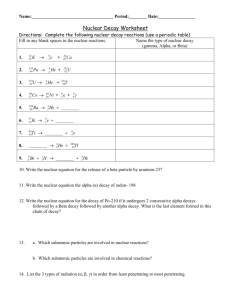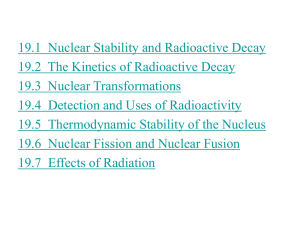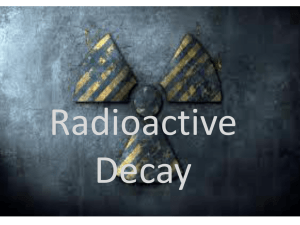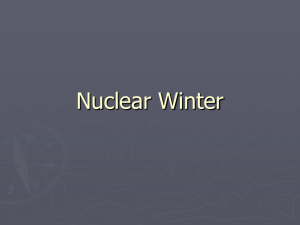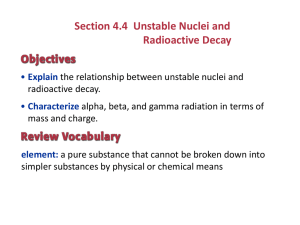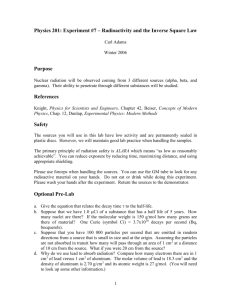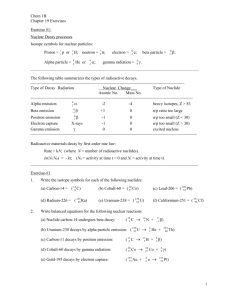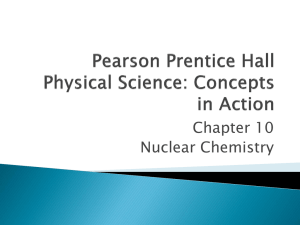PS Unit 10 Nuclear Reactions
advertisement
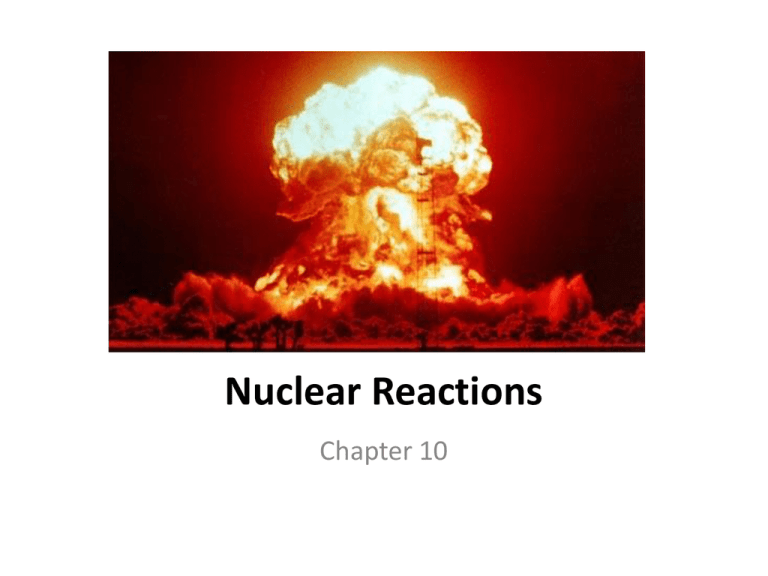
Nuclear Reactions Chapter 10 Standards • SPS3. Students will distinguish the characteristics and components of radioactivity • SPS3a. Differentiate among alpha and beta particles and gamma radiation. • SPS3b. Differentiate between fission and fusion. • SPS3c. Explain the process half-life as related to radioactive decay. • SPS3d. Describe nuclear energy, its practical application as an alternative energy source, and its potential problems. Nuclear Radiation Radioactive Decay: unstable isotopes emit particles and release energy to become stable isotopes. • after radioactive decay, the element changes into a different isotope of the same element or into an entirely different element. Radiation Nuclear Radiation: particles and energy released from the nucleus during radioactive decay. Types of Radiation • Alpha () -protons and neutrons • Beta-minus (-) -electrons and positrons • Gamma () -high-energy photons 4 2 He 2+ paper 0 -1 1- lead e 0 concrete Types of Nuclear Radiation (pg 238) Radiation Type Alpha particle Symbol What is it? Mass (kg) 2 protons and 2 neutrons 6.646x10-27 Charge Travel depth through materials +2 Least far due to massive size -1, (+1) Farther than alpha, but still not far Beta particle Fast-moving electrons or 9.109x10-31 positrons Gamma ray Form of electromagnetic energy None 0 Through clothes; Can cause harm Neutron A neutron leaving the nucleus 1.675x10-27 0 Penetrate the farthest Nuclear Decay • Anytime an unstable nucleus emits alpha or beta particles, the number of protons and neutrons changes. • Alpha decay: atomic mass and number change • Beta decay: atomic number changes • Gamma decay: energy of the nucleus is lower, but no change in atomic number or mass Nuclear Decay • Why nuclide (nucleus of an isotope) decay… to obtain a stable ratio of neutrons to protons 39 19 40 19 K Stable K Unstable (radioactive) Alpha Decay 226 88 Ra 222 86 4 2 Rn + He 226 = 222 + 4 88 = 86 + 2 (atomic mass & atomic number change) Beta Decay Equations 14 6 C 14 7 C + 0 -1 e 14 = 14 + 0 6 = 7 + (-1) (atomic mass stays the same; atomic number changes by 1) Actinium-217 decays by releasing an alpha particle. Write the equation for this decay process and determine which element is formed. 227 89 Ac + X Z A 4 2 He Complete the following radioactive-decay equation. Identify the isotope X. Indicate whether alpha or beta decay takes place. 63 28 Ni A Z X + e 0 -1 Radioactive Decay Rates • Half-life: time in which half of a radioactive substance decays; measure of how quickly a substance decays. -Iodine-131: used by doctors to diagnose medical problems -Potassium-40: used by geologists to predict the age of rocks Calculating Half-Life • Radium-226 has a half-life of 1599 years. How long will 7/8 of a sample take to decay? 1. Find out how much will be left. 8/8 - 7/8 = 1/8 left over 2. Calculate how many half-lives until only 1/8 is left. One half life Two half lives Three half lives 1/2 1/4 1/8 3. Calculate how many years it will take for 3 half lives to occur. 1599 x 3 = 4797 years 1 Nuclear Fission • Nuclear fission: the process by which a nucleus splits and neutrons and energy are released. • Nuclear chain reaction: a continuous series of fission reactions (pg 340) Nuclear Fusion • Nuclear fusion: when 2 light nuclei combine to form a heavier nuclei -Hydrogen is turned into Helium on the sun. (pg 342) Radiation on Earth • All around you. • Background radiation: arises naturally from the sun, soil, rocks, and plants • You are exposed to more radiation in the mountains than at sea level Beneficial Uses of Radiation • Smoke detectors release alpha particles • Radiation is used in x rays, MRIs, CT scans, PET scans, and ultrasounds • Radiation therapy is used to treat cancer • Used in agriculture to track the flow of water Nuclear Radiation Risks • High levels of radiation exposure can cause radiation sickness • High concentrations of radon gas can cause cancer Nuclear Power Advantages Disadvantages Does not produce greenhouse gases Radioactive products must be handled and stored carefully so they do not escape. Much more energy available in Expensive to build due to many uranium reserves than gas and safety regulations. coal. Waste must be stored in areas away from people, homes, water, earthquakes.



